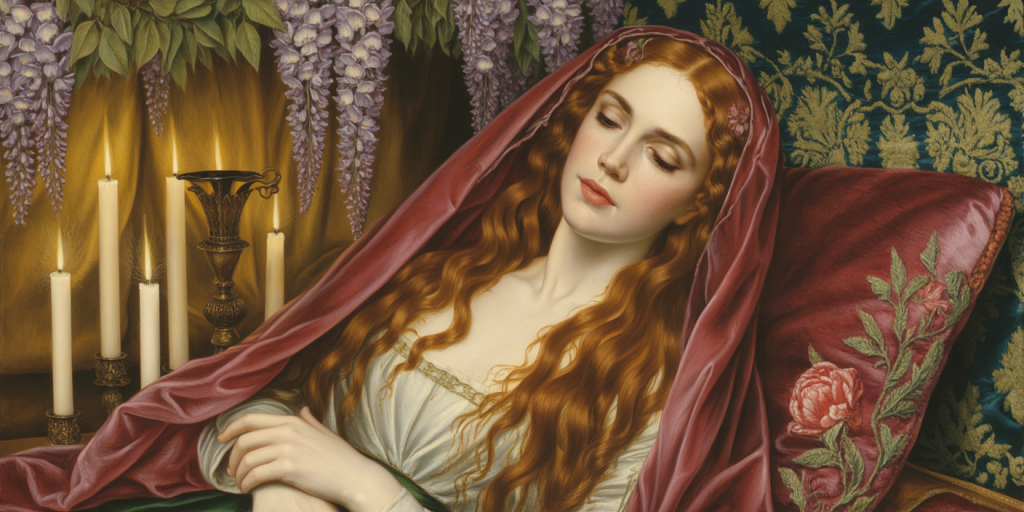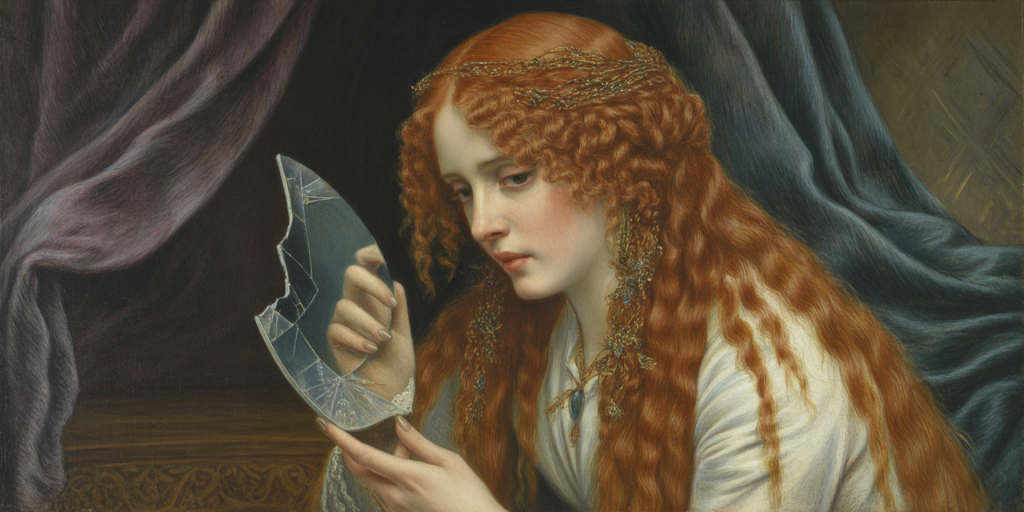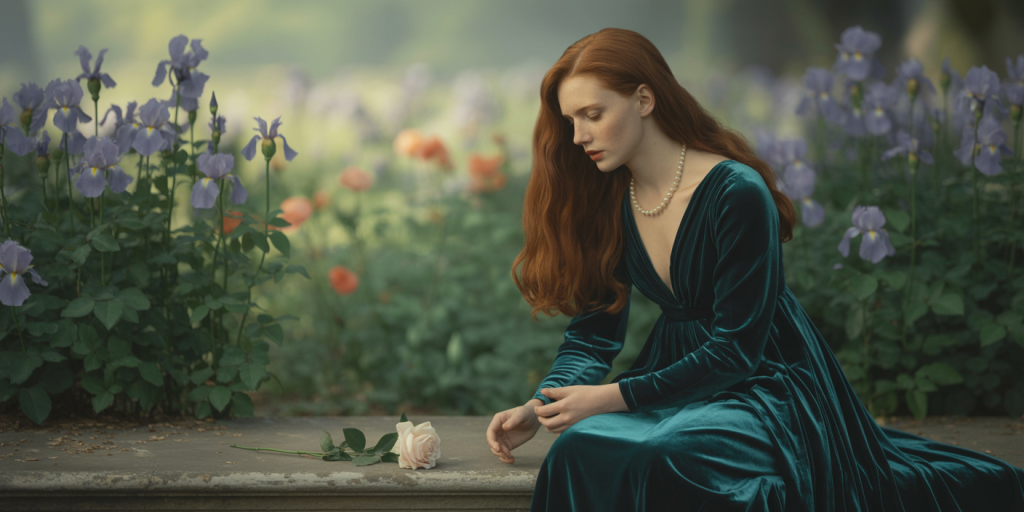The Mystic Marriage of Rossetti with the Feminine
The article “The Mystic Marriage of Rossetti with the Feminine Absence” will begin with a contemplative prelude, evoking the veils of longing and the spectral caress of memory that mark the oeuvre of Dante Gabriel Rossetti. The soul of the Pre-Raphaelite master will unfold through symbols, textures, and eternal gazes frozen between brushstrokes and silence.
A Prelude in Absence and Rose Petals
There is a hush that falls over the canvas before one sees it—the breathless quiet that precedes apparition. The world of Dante Gabriel Rossetti is not one of sound but of the hush after a whisper, the stillness after a heartbeat. In his portraits of women, time collapses. The body remains, but the soul, perhaps, has just slipped behind the silk curtain. Each figure looks outward and inward, caught between being muse and phantom, between flesh and elegy. The colors are not pigments; they are incarnations of absence.
The marriage Rossetti performs is not of bodies, but of memory and myth. His women are not entirely present, nor entirely gone. They live in an in-between, where the soul becomes symbol, and love becomes invocation. Through crimson locks and alabaster skin, Rossetti weds himself to the image of what was lost—or was never fully known.
Table of Contents
- The Crimson Veilof Reverie
- Silk Draperies and the Language of Skin
- Flowers That Never Wilt in Paint
- Flowers That Never Wilt in Paint
- The Hollow Between Gaze and Ghost
- A Palette Weeping Through Gold and Blue
- Ophelia Reborn as Flame
- Hands Folded like Forgotten Prayers
- The Mirror in the Frame of the Beloved
- Elusive Symbols in Every Earring and Veil
- Dreaming Through the Lens of a Poet
- Shadows as SacredBridesmaids
- The Body Lit by a Distant Moon
- Textures of Flesh and Lament
- When Light Kisses Melancholy
- Rituals of the Brushstroke
- The Soul Etched into the Iris
- Divine Echoes of Lizzie Siddal
- Grief Draped in Brocade
- Between Love and the Sepulcher
The Crimson Veil of Reverie
In Rossetti’s world, red is not merely a color. It is a reverie, a pulsation of passion and loss wrapped in velvet. The deep crimson that often envelops his female subjects is a curtain—not to conceal but to invoke. It is a veil through which memory breathes, fragile and smoldering. This red becomes a womb of nostalgia, inviting the viewer to peer into a sacred inner chamber.
Rossetti used rich layers to create an atmosphere where blood and dream intertwined. The red is both sensual and spiritual, a symbol of eros and eternity. It is the veil of bridal love and of mourning—the two fused into one indivisible emotion.
Silk Draperies and the Language of Skin
The draperies in Rossetti’s works do not merely clothe; they communicate. They wrap the figure in longing and texture, sliding between concealment and revelation. The folds mimic the undulations of thought, of memory, of the unspoken.
He paints skin like silk, and silk like breath—delicate, expectant. The tactile quality of his brushwork gives his figures a kind of hushed tactility, as if they had been dreamed into materiality. These textures turn the painted surface into a membrane between soul and surface.

Flowers That Never Wilt in Paint
Rossetti’s floral motifs bloom eternally. Lilies, poppies, roses—they grow not in soil, but in memory. Each petal is an allusion, each stem a thread in the tapestry of mourning and love. A rose at the ear is not an adornment but a whisper of sorrow or desire.
These flowers function as alchemical talismans. They suggest that time has stopped, that the subject is not aging but existing in a suspended ritual of beauty. Like pressed flowers between pages, they preserve what the world forgets.
The Hollow Between Gaze and Ghost
The eyes in Rossetti’s portraits do not stare—they haunt. Their gaze is a paradox: direct yet absent, intimate yet unreachable. There is a vacancy behind the irises, a field of mist that swallows clarity. It is in this hollow that the soul becomes visible.
This gaze is a mirror turned inward, reflecting the space where the artist projected his longing, his idealizations, his grief. The ghost in the gaze is not that of the subject—but of Rossetti himself.
A Palette Weeping Through Gold and Blue
Rossetti’s colors are wet with feeling. The use of blue and gold, in particular, creates an interplay between divinity and melancholy. Blue cools the skin with distance, with solitude. Gold warms the form with sacred breath.
His palette does not serve realism but symbolism. Blue halos the feminine as eternal. Gold dresses her in the light of remembrance. In this chromatic liturgy, the absence becomes divine.
Ophelia Reborn as Flame
Rossetti resurrects the Ophelia archetype, but his muse does not drown—she smolders. The woman in his canvas is fire, not water. She does not fade passively; she burns slowly from within.
The Pre-Raphaelite ideal is thus transformed: no longer a symbol of weakness, the feminine becomes an eternal ember, luminous and untouchable. Rossetti paints not death, but transmutation.
Hands Folded like Forgotten Prayers
The positioning of hands in Rossetti’s paintings is never incidental. They are relics of quiet rituals—folded in front of the chest, gently resting on a table, clasping an invisible memory. Each gesture is a prayer spoken in silence.

Hands become metaphors of restraint, of waiting, of devotion that outlives the body. They echo the tension of someone yearning, not for touch, but for something that has already slipped through.
Hair as a River of Time
Rossetti’s obsession with hair is almost mythic. The cascading red, brown, or golden strands become rivers of history, meandering through the canvas. They are timelines made sensual.
In their repetition and volume, hair often overflows the frame, suggesting abundance but also entrapment. The strands are ropes of memory, binding the subject to the past—binding Rossetti to the muse he could never completely hold.
The Mirror in the Frame of the Beloved
Each painting by Rossetti is not just an image of a woman, but a mirror. It is framed by the beloved, but reflects the artist. Her body becomes the frame through which we view his yearning.
Her stillness is his silence. Her adornments are his metaphors. Her beauty is the lens through which he contemplates absence. The mirror is framed not in gold, but in ache.
Elusive Symbols in Every Earring and Veil
Rossetti layered his compositions with objects that murmur meaning: a pearl earring, a translucent veil, a richly embroidered bodice. Each detail is a fragment of a sentence the painting whispers to the viewer.
These ornaments are not decorative but alchemical. They carry the charge of memory, hint at religious or romantic symbolism, and transform the subject into a mythic figure. They are metaphors sewn into fabric and flesh.
Dreaming Through the Lens of a Poet
As a poet and painter, Rossetti dreams in dual languages. His paintings are stanzas; his verses, brushstrokes. The cross-pollination of disciplines yields artworks steeped in lyricism.
His canvas does not illustrate—it intones. It moans, laments, exalts. In the texture of a dress or the line of a jaw, there is poetry. His muse is both metaphor and material.
Shadows as Sacred Bridesmaids
Shadows follow Rossetti’s figures like mourners or silent bridesmaids. They do not cast darkness but soften the edges, infusing the subject with a kind of spiritual chiaroscuro.
These shadows give volume to the void, holding within them the outlines of something unnamed. They are attendants to the marriage of memory and form.
The Body Lit by a Distant Moon
Light in Rossetti’s works seldom emanates from a direct source. Instead, it glows as if refracted from memory or dream—a moonlight that barely kisses the cheek, that hovers in the folds of fabric.
This indirect illumination imbues the body with a spectral softness. It is not sunlight but soul-light, making each figure appear as if she stepped out of the subconscious.
Textures of Flesh and Lament
Rossetti’s brush is gentle but insistent. It smooths the skin like alabaster, gives fabric the feel of breath. But within that delicacy lies a depth of sorrow.
The textures of his paintings are tactile elegies. They invite not only sight but a yearning to touch, to console, to remember. They are poems stitched into pigment.
When Light Kisses Melancholy
There is a tender interplay in Rossetti’s palette—a light that does not banish shadow, but embraces it. This merging creates an atmosphere of luminous melancholy.
In this light, sorrow does not appear tragic but sacred. It is the glow of what lingers, what still breathes in the absence. His art becomes a sanctuary where pain is sanctified.
Rituals of the Brushstroke
Rossetti painted with reverence. Each stroke was a ritual of remembrance, a liturgy of longing. The repetition of form—full lips, arched necks, heavy eyelids—became incantations.
His process was not mechanical but meditative. The act of painting was an invocation, conjuring not a model, but an essence. His brush translated ache into image.
The Soul Etched into the Iris
It is in the eyes where Rossetti’s spiritual engraving is most profound. The iris holds not light, but memory. Within it, he buries the soul of the beloved, and perhaps, a piece of his own.
There is always something unsaid behind those pupils, something once whispered and never heard. It is this mystery that keeps the viewer staring, waiting for the echo.
Divine Echoes of Lizzie Siddal
Lizzie Siddal is more than a muse—she is Rossetti’s altar, his oracle. Her image echoes across his oeuvre, not merely replicated, but re-consecrated. Through her, he sanctifies absence.
Their tragic love, enshrined in both verse and image, imbues every canvas with mourning. She is the absence that birthed presence—the hollow that made art possible.
Grief Draped in Brocade
Rossetti’s women are often clothed in opulent textures, but beneath them lies mourning. The gold, the embroidery, the shimmer—these are not signs of celebration, but veils for grief.

His opulence is a burial rite. In richness, he conceals emptiness. Every fold of brocade is a sigh, every shimmer a tear held too long.
Between Love and the Sepulcher
Rossetti’s mystic marriage is not consummated in joy, but in elegy. Love and death entwine in his brushwork, his verse, his memory. The beloved becomes both bride and mourner.
In painting her, he performs a rite of mourning and a vow of love. She lies between the altar and the tomb. And Rossetti, ever the priest of memory, paints the sacrament of absence.
FAQ
Who was Dante Gabriel Rossetti?
An English painter and poet, co-founder of the Pre-Raphaelite Brotherhood, known for his deeply symbolic and emotionally charged depictions of idealized women and mythic love.
What defines his painting style?
Lush color, rich textures, poetic symbolism, and deeply emotional portrayals of women, often blending personal loss and mythical themes.
Who was Lizzie Siddal?
His muse, wife, and tragic inspiration. She appears in many of his works and remains central to his mythos.
Why is absence a central theme in his art?
Rossetti’s grief, longing, and idealization of the feminine shaped his recurring portrayals of ethereal, unattainable beauty.
What is meant by ‘mystic marriage’?
A symbolic union between artist and muse, memory and vision, often evoking spiritual, romantic, and melancholic overtones.
Notes from the Chapel of Longing
Rossetti did not paint to remember—he painted to preserve the void. His women are not meant to live in our world, but in the sacred space between memory and myth. Each canvas is a reliquary. Each brushstroke, a prayer.
The mystic marriage he performs is not with the woman herself, but with her absence, her silence, her echo. And in that ritual, we are all made witnesses—not of union, but of the beauty that blooms where longing lives.
